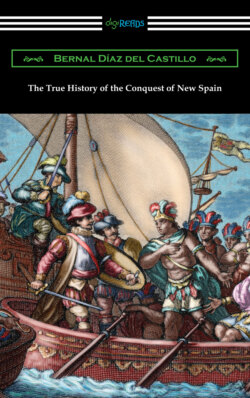Читать книгу The True History of the Conquest of New Spain - Bernal Diaz del Castillo - Страница 39
На сайте Литреса книга снята с продажи.
CHAPTER XXXIII.
ОглавлениеCortes issues orders that we should hold ourselves in readiness to march against the Indians on the following day; he also commands the horses to be brought on shore. How the battle terminates we fought with them.
Cortes being now certain that the Indians would renew the attack, immediately ordered all our horses to be brought on shore, and every one, our wounded not excepted, to hold himself in readiness. When our horses, which had been such a length of time at sea, now stepped on firm ground again, they appeared very awkward and full of fear; however, the day following, they had regained their usual liveliness and agility. There were also six or seven of our men, all young and otherwise strong fellows, who were attacked with such severe pains in the groins that they could not walk without support. No one could guess the cause of this; it was only said they had lived too freely at Cuba, and that the pain was occasioned by the heat, and the weight of their arms; Cortes, therefore, ordered them again on board. The cavaliers, who were to fight on horseback, were commanded to hang bells around their horses’ necks, and Cortes impressed on their minds not to rush at the Indians with their lances before they had been dispersed, and then even to aim at their faces only. The following men were selected to fight on horseback: Christobal de Oli, Pedro de Alvarado, Alonso Hernandez Puertocarrero, and Juan de Escalante. Francisco de Montejo and Alonso de Avila were to use the horses of Ortiz the musician, and of a certain Bartolome Garcia, though neither were worth much. Further, there were Velasquez de Leon, Francisco de Morla, and one of the Lares, (for there was another excellent horseman among us of that name,) and Gonzalo Dominiguez, both superior horsemen; lastly, there were Moron de Bayamo and Pedro de Truxillo. Then comes Cortes, who placed himself at their head. Mesa had charge of the artillery, while the rest of our men were commanded by Diego de Ordas, who, though he knew nothing of the cavalry service, excelled as a crossbow-man and musketeer. The morning following, which was the day of annunciation to the holy Virgin, we attended mass very early, and arranged ourselves under our ensign Antonio de Villareal. We now put ourselves in motion, and marched towards some extensive bean fields, where Francisco de Lugo and Pedro de Alvarado had fought the previous battle. There was a village in this neighbourhood called Cintla, belonging to the Tabascans, which lay about four miles from our head-quarters. Cortes, on account of the bogs which our horse could not pass, was obliged to take a circuitous route. Our other troops, however, under Diego de Ordas, came up with the Indians near Cintla, where they had arranged themselves on the plain: if they felt equal ardour for the combat as we did, they could now satisfy themselves,—for this was a battle in every sense of the word which we here fought, fearful in the extreme, as will be seen.
